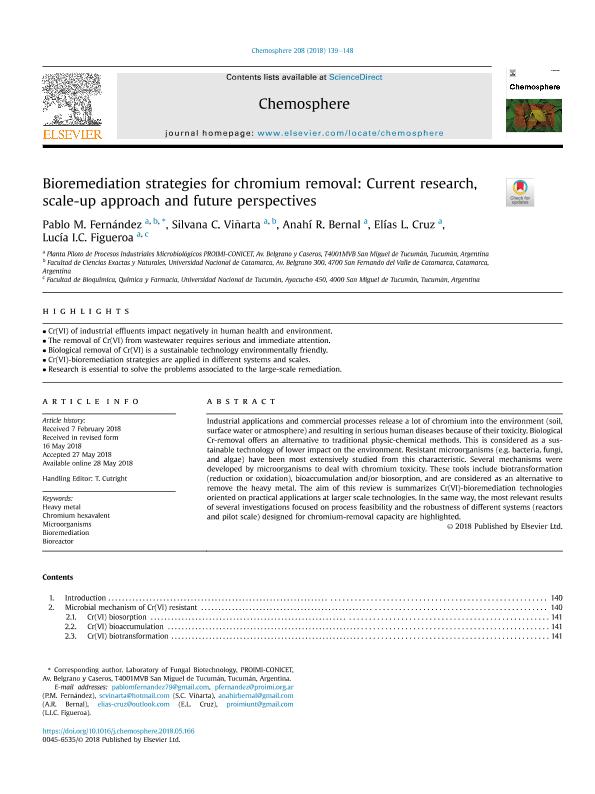Mostrar el registro sencillo del ítem
dc.contributor.author
Fernández, Pablo Marcelo

dc.contributor.author
Viñarta, Silvana Carolina

dc.contributor.author
Bernal, Anahi Romina

dc.contributor.author
Castellanos, Lucia Ines

dc.date.available
2019-08-28T14:21:14Z
dc.date.issued
2018-05
dc.identifier.citation
Fernández, Pablo Marcelo; Viñarta, Silvana Carolina; Bernal, Anahi Romina; Castellanos, Lucia Ines; Bioremediation strategies for chromium removal: Current research, scale-up approach and future perspectives; Pergamon-Elsevier Science Ltd; Chemosphere; 208; 10; 5-2018; 139-148
dc.identifier.issn
1879-1298
dc.identifier.uri
http://hdl.handle.net/11336/82350
dc.description.abstract
Industrial applications and commercial processes release a lot of chromium into the environment (soil, surface water or atmosphere) and resulting in serious human health diseases because of their toxicity. Biological Cr-removal offers an alternative to traditional physic-chemical methods. This is considered as a sustainable technology of lower impact on the environment. Resistant microorganisms (e.g. bacteria, fungi, and algae) have been most extensively studied from this characteristic. Microorganisms have evolved diverse mechanisms to cope with Cr toxicity. These tools include the metal uptake, which can either occur actively (bioaccumulation) or passively (biosorption), and/or the biotransformation (reduction or oxidation), are considered as an alternative to remove the heavy metal. The aim of this paper is summarizes Cr(VI)-bioremediation technologies oriented on practical applications at larger scale technologies. In the same way, a comparative study of different systems (reactors) and the most relevant results of several investigations focused on the evaluation of the process feasibility and the robustness of the pilot scale system trials in chromium-removal capacity are highlighted.
dc.format
application/pdf
dc.language.iso
eng
dc.publisher
Pergamon-Elsevier Science Ltd

dc.rights
info:eu-repo/semantics/openAccess
dc.rights.uri
https://creativecommons.org/licenses/by-nc-sa/2.5/ar/
dc.subject
Heavy Metal
dc.subject
Chromium Hexavalent
dc.subject
Microorganisms
dc.subject
Bioremeditaion
dc.subject.classification
Bioremediación, Diagnóstico Biotecnológico en Gestión Medioambiental

dc.subject.classification
Biotecnología del Medio Ambiente

dc.subject.classification
INGENIERÍAS Y TECNOLOGÍAS

dc.title
Bioremediation strategies for chromium removal: Current research, scale-up approach and future perspectives
dc.type
info:eu-repo/semantics/article
dc.type
info:ar-repo/semantics/artículo
dc.type
info:eu-repo/semantics/publishedVersion
dc.date.updated
2019-08-27T13:30:08Z
dc.identifier.eissn
0045-6535
dc.journal.volume
208
dc.journal.number
10
dc.journal.pagination
139-148
dc.journal.pais
Estados Unidos

dc.journal.ciudad
Amsterdam
dc.description.fil
Fil: Fernández, Pablo Marcelo. Consejo Nacional de Investigaciones Científicas y Técnicas. Centro Científico Tecnológico Conicet - Tucumán. Planta Piloto de Procesos Industriales Microbiológicos; Argentina
dc.description.fil
Fil: Viñarta, Silvana Carolina. Consejo Nacional de Investigaciones Científicas y Técnicas. Centro Científico Tecnológico Conicet - Tucumán. Planta Piloto de Procesos Industriales Microbiológicos; Argentina
dc.description.fil
Fil: Bernal, Anahi Romina. Consejo Nacional de Investigaciones Científicas y Técnicas. Centro Científico Tecnológico Conicet - Tucumán. Planta Piloto de Procesos Industriales Microbiológicos; Argentina
dc.description.fil
Fil: Castellanos, Lucia Ines. Consejo Nacional de Investigaciones Científicas y Técnicas. Centro Científico Tecnológico Conicet - Tucumán. Planta Piloto de Procesos Industriales Microbiológicos; Argentina
dc.journal.title
Chemosphere

dc.relation.alternativeid
info:eu-repo/semantics/altIdentifier/url/https://linkinghub.elsevier.com/retrieve/pii/S0045653518310233
dc.relation.alternativeid
info:eu-repo/semantics/altIdentifier/doi/https://doi.org/10.1016/j.chemosphere.2018.05.166
Archivos asociados
